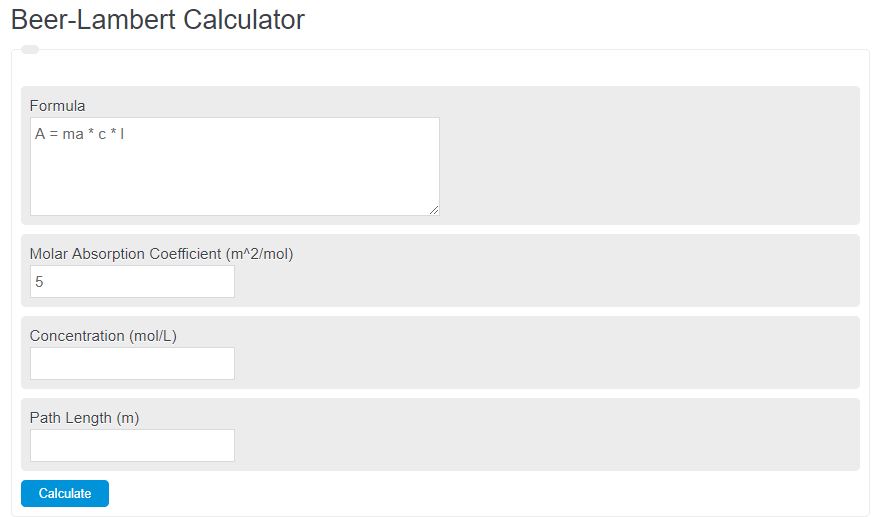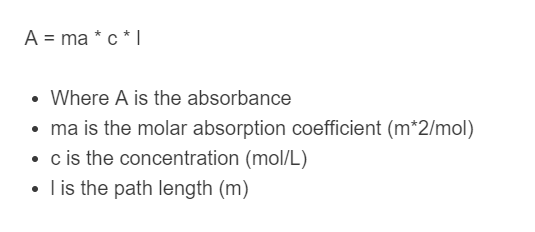Enter the molar absorption coefficient, concentration, and path length into the calculator to determine the total absorbance.
Beer-Lambert Law Formula
The following equation is used to calculate the absorbance of a substance.
A = ma * c * l
- Where A is the absorbance
- ma is the molar absorption coefficient (m*2/mol)
- c is the concentration (mol/L)
- l is the path length (m)
To calculate absorbance from the Beer-Lambert Law, multiply the molar absorption coefficient by the concentration, then multiply by the path length.
Beer-Lambert Law Definition
The Beer-Lambert Law, also known as the Beer-Lambert-Bouguer Law or simply Beer’s Law, is a fundamental principle in spectroscopy that relates the concentration of a solute in a solution to the absorption of light by that solution.
It is named after the scientists August Beer and Johann Lambert, who independently formulated the law in the mid-19th century.
The law states that the absorbance (A) of light passing through a sample is directly proportional to the concentration (c) of the absorbing species and the path length (l) that the light travels through the sample. Mathematically, this relationship is represented as A = εcl, where ε is the molar absorptivity or molar absorption coefficient, a constant unique to each absorbing species and wavelength of light.
The Beer-Lambert Law is crucial in various scientific disciplines, particularly chemistry, biochemistry, and environmental science. It provides a quantitative method to determine the concentration of a solute in a solution by measuring the absorbance of light at a specific wavelength.
This enables scientists to analyze the composition and concentration of substances, such as pollutants in water, reactants in chemical reactions, or biomolecules in biological samples.
Beer-Lambert Law Example
How to calculate absorption from the Beer-Lambert law?
- First, determine the coefficient.
Calculate the molar absorption coefficient of the substance.
- Next, determine the concentration.
Calculate the concentration of the substance.
- Next, determine the path length.
Calculate the length of the path in which the substance can be absorbed.
- Finally, calculate the absorption.
Calculate the absorption using the formula above.
FAQ
What is the significance of the molar absorption coefficient in the Beer-Lambert Law?
The molar absorption coefficient (ε) is a measure of how strongly a chemical species absorbs light at a given wavelength. It is a crucial factor in the Beer-Lambert Law, determining the proportionality between the concentration of the species and the absorbance of light, making it essential for accurate calculations of solute concentration.
How can the Beer-Lambert Law be applied in real-world scenarios?
The Beer-Lambert Law is widely used in various scientific fields such as chemistry, biochemistry, and environmental science. It is applied in determining the concentration of pollutants in water, measuring the rates of chemical reactions, and analyzing the concentration of biomolecules in biological samples, among other applications.
Are there any limitations to the Beer-Lambert Law?
Yes, the Beer-Lambert Law has limitations. It assumes that the system is homogenous and the light absorption is uniform, which might not be the case in complex mixtures. It also assumes that there is no light scattering or fluorescence, and that the law may not hold at very high concentrations due to deviations caused by molecular interactions.
Can the Beer-Lambert Law be used with any wavelength of light?
While the Beer-Lambert Law can be applied across a wide range of wavelengths, the choice of wavelength is crucial and depends on the absorbing species being studied. The wavelength selected must correspond to an absorption band of the substance to ensure accurate measurements. This is because the molar absorption coefficient (ε) varies with wavelength.

